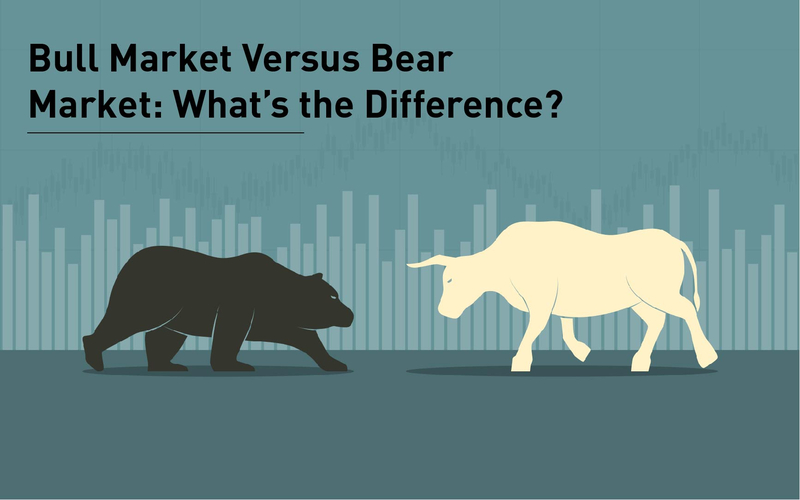Table of Contents
Bull Vs Bear Market: What’s the Difference?
In this post we’re going to explain one thing: Bull Market Vs Bear Market. Figuring out whether it’s a bull market or a bear market can better help you determine what types of investments are best suited to the overall mood of the market right now.
Bulls and bears aren’t just for the zoo or sports teams. In the financial world, they’re specific terms that are used to refer to different stock market conditions.
While the rules of the stock market remain constant, the overall tone of the market is ever-changing.
Here, we’ll delve into the difference between a bull and a bear market, and how to take advantage of both.
Download the key points of this post as PDF.
What is a bull market?
A bull market makes for ebullient times in the stock market. These are the times when prices are on the rise or there are strong expectations that they will rise in the near future.
- Think of a bull, rushing forward, pushing those prices upward with its horns.
- A bull market is characterized by plenty of optimism, high expectations, and a high level of investor confidence in general.
- Usually, bull markets are determined by a 20 percent rise in stock prices. This is often preceded by a drop in prices, and comes before a decline in prices.
What type of trading works in a bull market?
If you’re a bullish investor, you’re buying a stock with the expectation that it will go up in price.
Bull markets are the time to go longer in positions, as they are more likely to appreciate in value during these times.
What is a bear market?

A bear market is the opposite of a bull market.
- Instead of a bold, forward-moving bull, think of a grumpy bear hibernating.
- In a bear market, stock prices are falling, or there is an expectation that they will fall.
- This results in a general pessimistic attitude and low expectations.
Investors are cautious and tend toward penny pinching, which keeps the market in the state of decline.
What type of trading works in a bear market?
When stock prices are going down, a bearish investor is typically unwilling to go long on a position. This means it’s the right time to take advantage of short sales.
Short selling means that you’re borrowing shares of a stock and then selling them, with the expectation that the price will fall. The idea is that after you sell, you can buy it back at a lower price, give the shares back to the broker from which you borrowed them, and keep that difference in price for yourself.
While it may sound funny to trading newbies, this is actually a method of investing which has been around since the days of legendary investor Jesse Livermore.
If you’re interested in short selling, you have to be extremely diligent in doing research, relying on plenty of analysis before executing a trade. Your losses could mount quickly and things can get very scary very fast when selling short!
Additionally, shorting isn’t always the easiest method of trading. You have to borrow shares to short, and sometimes these can be hard to come by.
How can you tell if it’s a bull or a bear market?
There isn’t a clear-cut switch that indicates whether we’re in a bull versus a bear market.
The market is cyclical, so timelines can be very hard to predict. There are also natural pullbacks that can indicate optimism or pessimism, so sometimes it can be hard to discern which type of market we’re in.
Typically, investors stick to the “20 percent rule”. This means the market rises 20 percent over a period of time (two months or more is a good general rule) it can be considered a bear market; the opposite would be true for indicating a bear market.
Often, it’s only possible to tell if we’re in a bull or a bear market after we’re already in it.
Bull Vs Bear Market: is there a winner?

Some investors have opinions on which type of market is better than the other. However, these are usually based on the style of investing they prefer.
When it comes down to it, one type of market isn’t better than the other. They’re simply different.
Conclusion: Both bull and bear markets can provide different opportunities for investors. Optimistic bull markets can provide opportunities to go long on positions, where more pessimistic bear markets can offer the chance to benefit from taking short positions.
As an investor, you can take advantage of both types of markets. The key is adapting your trading techniques so that you can best take advantage of the type of market you’re in right now.
Do you consider yourself a bullish or bearish investor?
Don’t be shy, let us know in the comments below! 🙂
What Do We Recommend Next?
Try StocksToTrade for 7 Full Days for just $7.00!
StocksToTrade was built by traders for traders. Cut the amount of time, stress, and anxiety you experience behind the keyboard and only deal with the handful of real trade opportunities daily. Find the stocks that matter!

